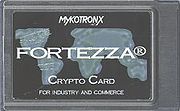
Fortezza
Encyclopedia

Information security
Information security means protecting information and information systems from unauthorized access, use, disclosure, disruption, modification, perusal, inspection, recording or destruction....
system based on a PC Card
PC Card
In computing, PC Card is the form factor of a peripheral interface designed for laptop computers. The PC Card standard was defined and developed by the Personal Computer Memory Card International Association which itself was created by a number of computer industry companies in the United States...
security token. Each individual who is authorized to see protected information is issued a Fortezza card that stores private keys and other data needed to gain access. It contains an NSA-approved security microprocessor called Capstone (MYK-80) that implements the Skipjack
Skipjack (cipher)
In cryptography, Skipjack is a block cipher—an algorithm for encryption—developed by the U.S. National Security Agency . Initially classified, it was originally intended for use in the controversial Clipper chip...
encryption
Encryption
In cryptography, encryption is the process of transforming information using an algorithm to make it unreadable to anyone except those possessing special knowledge, usually referred to as a key. The result of the process is encrypted information...
algorithm.
The Fortezza card has been used in government, military, and banking applications to protect sensitive data. The cards are interchangeable within the many types of equipment that support Fortezza and can be rekeyed and reprogrammed by the owners, making them easy to issue and reuse. This simplifies the process of rekeying equipment for crypto changes: instead of requiring an expensive fill device
Fill device
A fill device is an electronic module used to load cryptographic keys into electronic encryption machines. Fill devices are usually hand held and battery operated....
, a technician is able to put a new Fortezza card in the device's PCMCIA slot.
Fortezza was developed for the U.S. government's Clipper chip
Clipper chip
The Clipper chip was a chipset that was developed and promoted by the U.S. National Security Agency as an encryption device to be adopted by telecommunications companies for voice transmission...
project and has been used by the U.S. Government in various applications. The original Fortezza card (KOV-8) is a Type 2
Type 2 encryption
In cryptography, Type 2 products are unclassified cryptographic equipment, assemblies, or components, endorsed by the National Security Agency , for use in telecommunications and automated information systems for the protection of national security information.Note: The term refers only to...
product which means it cannot be used for classified information
Classified information
Classified information is sensitive information to which access is restricted by law or regulation to particular groups of persons. A formal security clearance is required to handle classified documents or access classified data. The clearance process requires a satisfactory background investigation...
. The most widely used Type 1 encryption
Type 1 encryption
In cryptography, a Type 1 product is a device or system certified by the National Security Agency for use in cryptographically securing classified U.S...
card is the KOV-12 Fortezza card which is used extensively for the Defense Message System
Defense Message System
The Defense Message System or Defense Messaging System is a deployment of secure electronic mail and directory services in the United States Department of Defense...
(DMS). The KOV-12 is cleared up to TOP SECRET/SCI. A later version, called KOV-14
KOV-14
The KOV-14 Fortezza Plus is a US National Security Agency-approved PC card which provides encryption functions and key storage to the Secure Terminal Equipment and other devices...
or Fortezza Plus, uses a Krypton microprocessor that implements stronger, Type 1 encryption
Type 1 encryption
In cryptography, a Type 1 product is a device or system certified by the National Security Agency for use in cryptographically securing classified U.S...
and may be used for information classified
Classified information in the United States
The United States government classification system is currently established under Executive Order 13526, the latest in a long series of executive orders on the topic. Issued by President Barack Obama in 2009, Executive Order 13526 replaced earlier executive orders on the topic and modified the...
up to TOP SECRET/SCI. It, in turn, is being replaced by the newer KSV-21
KSV-21
The KSV-21 Enhanced Crypto Card is a US National Security Agency-approved PC card that provides Type 1 encryption functions and key storage to the STE secure telephones and other devices....
PC card with more modern algorithms and additional capabilities.
The Fortezza Plus card and its successors are used with NSA's Secure Terminal Equipment
Secure Terminal Equipment
Secure Terminal Equipment is the U.S. Government's current , encrypted telephone communications system for wired or "landline" communications. STE is designed to use ISDN telephone lines which offer higher speeds of up to 128k bits per second and are all digital...
voice and data encryption systems that are replacing the STU-III
STU-III
STU-III is a family of secure telephones introduced in 1987 by the NSA for use by the United States government, its contractors, and its allies. STU-III desk units look much like typical office telephones, plug into a standard telephone wall jack and can make calls to any ordinary phone user...
. It is manufactured by the Mykotronx Corporation and by Spyrus. Each card costs about $240 and they are commonly used with card readers sold by Litronic Corporation.

